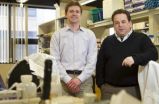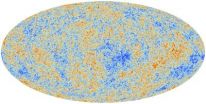(Press-News.org) Researchers from the RIKEN Advanced Science Institute and Nippon Medical School in Japan have identified a protein likely to be involved in the exacerbation of chronic obstructive pulmonary disease (COPD). This protein, Siglec-14, could serve as a potential new target for the treatment of COPD exacerbation.
In a study published today in the journal Cellular and Molecular Life Sciences the researchers show that COPD patients who do not express Siglec-14, a glycan-recognition protein, are less susceptible to exacerbation compared with those who do.
COPD is a chronic condition in which the airways and alveoli in the lungs become damaged, making it increasingly difficult for air to pass in and out. It is the 4th leading cause of death worldwide and its prevalence is on the rise. Exacerbation, or a sudden worsening of the COPD symptoms often triggered by bacterial or viral infection, directly leads to the decline of the quality of life, and even to the death, of the patient.
Based on the facts that Siglec-14, which is made by innate immune cells, binds to the bacteria that often trigger exacerbation, and that approximately 1 out of 4 people in Japan cannot make Siglec-14 because of genetic polymorphism, the research team led by Drs. Takashi Angata and Naoyuki Taniguchi (RIKEN Advanced Science Institute) and Drs. Takeo Ishii and Kozui Kida (Respiratory Care Clinic, Nippon Medical School) hypothesized that the presence of Siglec-14 may influence the frequency of exacerbation episodes in COPD patients.
The team analyzed the correlation between the genotype of SIGLEC14 gene and the frequency of COPD exacerbations during 1 year of monitoring in 135 COPD patients, and found that those patients who do not have Siglec-14 (31 patients) suffer far fewer episodes of exacerbations (nearly 80% less) on average compared with those who do (104 patients).
These findings by the team suggest that COPD patients may be stratified based on the SIGLEC14 genotype for more efficient and personalized care. They also imply that Siglec-14 protein is involved in the exacerbation of COPD, and that a compound that blocks the inflammatory events triggered by Siglec-14 engagement could be used to prevent or treat the exacerbation of COPD.
###
Reference
Takashi Angata, Takeo Ishii, Takashi Motegi, Ritsuko Oka, Rachel E. Taylor, Paula Campos Soto, Yung-Chi Chang, Ismael Secundino, Cong-Xiao Gao, Kazuaki Ohtsubo, Shinobu Kitazume, Victor Nizet, Ajit Varki, Akihiko Gemma, Kozui Kida, and Naoyuki Taniguchi. "Loss of Siglec-14 reduces the risk of chronic obstructive pulmonary disease exacerbation". Cellular and Molecular Life Sciences, 2013, doi: 10.1007/s00018-013-1311-7
About RIKEN
RIKEN is Japan's flagship research institute for basic and applied research. Over 2500 papers by RIKEN researchers are published every year in reputable scientific and technical journals, covering topics ranging across a broad spectrum of disciplines including physics, chemistry, biology, medical science and engineering. RIKEN's advanced research environment and strong emphasis on interdisciplinary collaboration has earned itself an unparalleled reputation for scientific excellence in Japan and around the world.
Website: http://www.riken.jp Find us on Twitter at @riken_en
Japanese researchers identify a protein linked to the exacerbation of COPD
2013-03-21
ELSE PRESS RELEASES FROM THIS DATE:
Scripps Research study underlines potential of new technology to diagnose disease
2013-03-21
JUPITER, FL – March 21, 2013 – Researchers at The Scripps Research Institute (TSRI) in Jupiter, FL, have developed cutting-edge technology that can successfully screen human blood for disease markers. This tool may hold the key to better diagnosing and understanding today's most pressing and puzzling health conditions, including autoimmune diseases.
"This study validates that the 'antigen surrogate' technology will indeed be a powerful tool for diagnostics," said Thomas Kodadek, PhD, a professor in the Departments of Chemistry and Cancer Biology and vice chairman of ...
BUSM researchers identify chemical compounds that halt virus replication
2013-03-21
(Boston) – Researchers at Boston University School of Medicine (BUSM) have identified a new chemical class of compounds that have the potential to block genetically diverse viruses from replicating. The findings, published in Chemistry & Biology, could allow for the development of broad-spectrum antiviral medications to treat a number of viruses, including the highly pathogenic Ebola and Marburg viruses.
Claire Marie Filone, PhD, postdoctoral researcher at BUSM and the United States Army Medical Research Institute of Infectious Diseases (USAMRIID), is the paper's first ...
ACMG releases report on incidental findings in clinical exome and genome sequencing
2013-03-21
The American College of Medical Genetics and Genomics (ACMG) released the widely-anticipated "ACMG Recommendations for Reporting of Incidental Findings in Clinical Exome and Genome Sequencing" report at its 2013 Annual Clinical Genetics Meeting today in Phoenix. The ACMG Annual Clinical Genetics Meeting is one of the largest gatherings of medical and health professionals in genetics in the world.
As exome and genome sequencing become more commonly used in medical care, doctors will increasingly be able to learn about genetic changes that increase an individual's risk ...
Can we treat a 'new' coronary heart disease risk factor?
2013-03-21
NEW YORK – Depressive symptoms after heart disease are associated with a markedly increased risk of death or another heart attack. However, less has been known about whether treating heart attack survivors for depressive symptoms could relieve these symptoms, be cost-effective, and ultimately, reduce medical risk? Columbia University Medical Center's Karina W. Davidson, PhD and her research team now report a patient-centered approach that answers these questions in the affirmative.
With a grant from the National Institutes of Health's National Heart, Lung, and Blood Institute ...
Exploring the link between traumatic brain injury and people who are homeless
2013-03-21
TORONTO, March 21, 2013—Homeless people and their health care providers need to know more about traumatic brain injuries to help prevent and treat such injuries, a new study has found.
Homeless people have a disproportionately higher risk for TBI compared to the general population, yet little is known about the severity of those injuries, who exactly is suffering from them and what the long-term consequences are.
"A better understanding of TBI, its presentation and characteristics in the homeless is vital in order to enable appropriate interventions, treatments, and ...
Dysfunction in cerebellar Calcium channel causes motor disorders and epilepsy
2013-03-21
A dysfunction of a certain Calcium channel, the so called P/Q-type channel, in neurons of the cerebellum is sufficient to cause different motor diseases as well as a special type of epilepsy. This is reported by the research team of Dr. Melanie Mark and Prof. Dr. Stefan Herlitze from the Ruhr-Universität Bochum. They investigated mice that lacked the ion channel of the P/Q-type in the modulatory input neurons of the cerebellum. "We expect that our results will contribute to the development of treatments for in particular children and young adults suffering from absence ...
Misregulated genes may have big autism role
2013-03-21
PROVIDENCE, R.I. [Brown University] — A new study finds that two genes individually associated with rare autism-related disorders are also jointly linked to more general forms of autism. The finding suggests a new genetic pathway to investigate in general autism research.
The genes encode the proteins NHE6 and NHE9, which are responsible for biochemical exchanges in the endosomes of cells. Mutations in the NHE6 gene are a direct cause of Christianson Syndrome, while mutations in the NHE9 gene lead to a severe form of autism with epilepsy. In the new study, a statistical ...
Planck's 'child' universe
2013-03-21
"We are very excited, we are finally seeing the concrete results of so many years of hard work". This is how the scientists of the Planck project have commented the first data resulting from the observations carried out by Planck. The mission of the ESA satellite is to observe the past of our Universe, going back in time and reaching the very first instant right after the Big Bang. The image that the Planck scientists convey today is that of a 'child' Universe, dating back to about 380,000 years after the Big Bang, when its temperature was similar to that of the most external ...
Genetic analysis calls for the protection of 2 highly endangered Portuguese fish species
2013-03-21
The two endangered fish species, Squalius aradensis and S. torgalensis, most generally belong to the Cyprinidae, or the carp family. This is the largest fish, and vertebrate family, formed of freshwater fish with a diversity of more than 2,400 species. The family also has an important economic value as a food source. More specifically, the two species studied are members of the subfamily Leuciscinae, formed of small freshwater fish commonly known as minnows. A new genetic study of the two endangered fish was recently published in the open access journal Comparative Cytogenetics.
S. ...
Genetics, age and ethnicity are risk factors in PCa, say experts
2013-03-21
"Are there genetic risk factors for PCa? Yes, and BRCA2 and HOXB13 are useful for predicting high-risk disease," said Jack Cuzick (GB) president of the International Society for Cancer Prevention (ISCaP), referring to the two genes implicated in high-risk prostate disease. Cuzick gave a report on the Consensus Statement for Prostate Cancer Prevention at the closing plenary session of the 28 Annual EAU Congress held in Milan, Italy from March 15 to 19.
"The goal should be to integrate with other protein markers in order to develop risk-adapted screening algorithms," he ...



